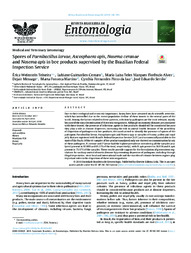Spores of Paenibacillus larvae, Ascosphaera apis, Nosema ceranae and Nosema apis in bee products supervised by the Brazilian Federal Inspection Service.
Spores of Paenibacillus larvae, Ascosphaera apis, Nosema ceranae and Nosema apis in bee products supervised by the Brazilian Federal Inspection Service.
Autoria: TEIXEIRA, É. W.; GUIMARÃES-CESTARO, L.; ALVES, M. L. T. M. F.; MESSAGE, D.; MARTINS, M. F.; LUZ, C. F. P. da; SERRÃO, J. E.
Resumo: Abstract Due to their ecological and economic importance, honey bees have attracted much scientific attention, which has intensified due to the recent population decline of these insects in the several parts of the world. Among the factors related to these patterns, infection by pathogens are the most relevant, mainly because of the easy dissemination of these microorganisms. Although no zoonotic diseases are associated with these insects, the presence of infectious agents in bee products should still be considered because they play a role as disease dispersers, increasing the risk to animal health. Because of the possibility of dispersion of pathogens via bee products, this work aimed to identify the presence of spores of the pathogens Paenibacillus larvae, Ascosphaera apis and Nosema spp. in samples of honey, pollen and royal jelly that are registered with Brazil's Federal Inspection Service (S.I.F.) and commercially available in the state of São Paulo. Of the 41 samples of bee products analyzed, only one showed no contamination by any of these pathogens. N. ceranae and P. larvae had the highest prevalence considering all the samples analyzed (present in 87.80% and 85.37% of the total, respectively), with N. apis present in 26.83% and A. apis present in 73.17% of the samples. These results provide support for the formulation of government regulations for sanitary control of exotic diseases by preventing dispersion of pathogens, including through illegal importation, since local and international trade and the transfer of colonies between regions play important roles in the dispersion of these microorganisms.
Ano de publicação: 2018
Tipo de publicação: Artigo de periódico
Unidade: Embrapa Gado de Leite
Palavras-chave: Apis Mellifera, Honey, Multiplex PCR, Pollen, Royal jelly
Observações
1 - Por padrão são exibidas publicações dos últimos 20 anos. Para encontrar publicações mais antigas, configure o filtro ano de publicação, colocando o ano a partir do qual você deseja encontrar publicações. O filtro está na coluna da esquerda na busca acima.
2 - Para ler algumas publicações da Embrapa (apenas as que estão em formato ePub), é necessário ter, no celular ou computador, um desses softwares gratuitos. Sistemas Android: Google Play Livros; IOS: iBooks; Windows e Linux: software Calibre.
Acesse outras publicações
Acesse a Base de Dados da Pesquisa Agropecuária (BDPA) para consultar o acervo completo das bibliotecas da Embrapa.

